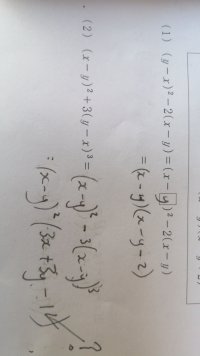You are using an out of date browser. It may not display this or other websites correctly.
You should upgrade or use an alternative browser.
You should upgrade or use an alternative browser.
Polynomial factorisation
- Thread starter Robegk
- Start date
Robegk, I got this:
\(\displaystyle (x - y)^2 \ + \ 3(y - x)^3 \ = \)
\(\displaystyle (x - y)^2 \ - \ 3(x - y)^3 \ = \)
\(\displaystyle (x - y)^2[1 - 3(x - y)] \ =\)
\(\displaystyle (x - y)^2(1 - 3x + 3y) \ = \)
\(\displaystyle (x - y)^2(-3x + 3y + 1)\)
___________________________
What did you get?
\(\displaystyle (x - y)^2 \ + \ 3(y - x)^3 \ = \)
\(\displaystyle (x - y)^2 \ - \ 3(x - y)^3 \ = \)
\(\displaystyle (x - y)^2[1 - 3(x - y)] \ =\)
\(\displaystyle (x - y)^2(1 - 3x + 3y) \ = \)
\(\displaystyle (x - y)^2(-3x + 3y + 1)\)
___________________________
What did you get?
Thank you for the detailed reply, can I ask you on step 3 of your workings where the 1 comes from, I can't understand it, sorryRobegk, I got this:
\(\displaystyle (x - y)^2 \ + \ 3(y - x)^3 \ = \)
\(\displaystyle (x - y)^2 \ - \ 3(x - y)^3 \ = \)
\(\displaystyle (x - y)^2[1 - 3(x - y)] \ =\)
\(\displaystyle (x - y)^2(1 - 3x + 3y) \ = \)
\(\displaystyle (x - y)^2(-3x + 3y + 1)\)
___________________________
What did you get?
Otis
Elite Member
- Joined
- Apr 22, 2015
- Messages
- 4,589
Hi Robegk. He factored out the expression (x-y)^2. Like this pattern:where the 1 comes from
z^2 - 3z^3 = z^2(1 - 3z)
If you're still puzzling over it, then use the distributive property to multiply out (expand) the right-hand side. Do that twice, with the 1 and without the 1, and see what happens.

